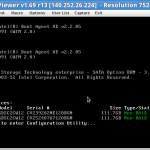First we need to identify the block devices that will be part of the new filesystem. In this example, we’re creating a new filesystem from disks directly attached to only one GPFS server that already has existing filesystems with disks attached to multiple server nodes.
# lsscsi
[0:0:0:0] disk ATA INTEL SSDSC2CW12 400i /dev/sda
[1:0:0:0] disk ATA INTEL SSDSC2CW12 400i /dev/sdb
[6:0:8:0] enclosu LSI CORP SAS2X36 0717 -
[6:0:9:0] enclosu LSI CORP SAS2X36 0717 -
[6:1:12:0] enclosu LSI SAS2X36 0e0b -
[6:1:34:0] enclosu LSI SAS2X36 0e0b -
[6:2:0:0] disk LSI MR9286CV-8e 3.23 /dev/sdc
[6:2:1:0] disk LSI MR9286CV-8e 3.23 /dev/sdd
[6:2:2:0] disk LSI MR9286CV-8e 3.23 /dev/sde
[6:2:3:0] disk LSI MR9286CV-8e 3.23 /dev/sdf
[6:2:4:0] disk LSI MR9286CV-8e 3.23 /dev/sdg
[6:2:5:0] disk LSI MR9286CV-8e 3.23 /dev/sdh
[6:2:6:0] disk LSI MR9286CV-8e 3.23 /dev/sdi
[6:2:7:0] disk LSI MR9286CV-8e 3.23 /dev/sdj
# mmlsnsd -m | grep `hostname`
foo_nsd1 8CFC1C0B507CC600 /dev/sdc foo.example.com server node
foo_nsd2 8CFC1C0B507CC602 /dev/sdd foo.example.com server node
foo_nsd3 8CFC1C0B507CC605 /dev/sde foo.example.com server node
foo_nsd4 8CFC1C0B5122CB3C /dev/sdf foo.example.com server node
By manually comparing the two lists of block devices, we see that /dev/sd[ghij] are the new block devices that don’t have a GPFS NSD.
We need to create an NSD for each new block device.
Continue Reading →

